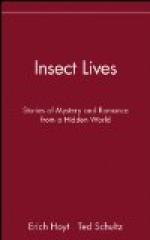One interesting and suggestive fact remains to be mentioned. There are grasshoppers and cockroaches in which the changes are even less than those just sketched, because the wings remain, even in the adult, in a rudimentary state (as for example in the female of the common kitchen cockroach, Blatta orientalis, see fig. 4 a), or are never developed at all. Such exceptional winglessness in members of a winged family can only be explained by the recognition of a life-story, not merely in the individual but in the race. We cannot doubt that the ancestors of these wingless insects possessed wings, which in the course of time have been lost by the whole species or by the members of the female sex. It is generally assumed that this loss has been gradual, and so in many cases it probably may have been. But there are species of insects in which some generations are winged and others wingless; a winged mother gives birth to wingless offspring, and a wingless parent to young with well-developed wings. Such discontinuity in the life-story of a single generation forces us to recognise the possibility of similar sudden mutations in the course of that age-long process of evolution to which the facts of insect growth, and indeed of all animal development, bear striking testimony.
CHAPTER III
THE LIFE-STORIES OF SOME SUCKING INSECTS
We may now turn our attention to some examples of the remarkable alternation of winged and wingless generations in the yearly life-cycle of the same species, mentioned at the end of the last chapter. Cockroaches and grasshoppers belong to an order of insects, the Orthoptera[5], characterised by firm forewings and biting jaws; in all of them the change of form during the life-history is comparatively slight. A great contrast to those insects in the structure of the mouth-parts is presented by the Hemiptera, an order including the bugs, pond-skaters, cicads, plant-lice, and scale-insects. These all have an elongated, grooved labium projecting from the head in form of a beak, within which work, to and fro, the slender needle-like mandibles and maxillae by means of which the insect pierces holes through the skin of a leaf or an animal, and is thus enabled to suck a meal of sap or blood, according to its mode of life. In many Hemiptera—the various families of bugs both aquatic and terrestrial, for example—the life-history is nearly as simple as that of a cockroach. It is the family of the plant-lice (Aphidae) that affords typical illustrations of that alternation of generations to which reference has been made.
[5] See outline classification of insects, p. 122.




